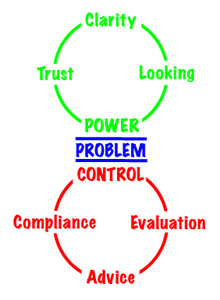
The Power Or Control Model
This model is equally powerful for handling our own defense mechanisms. Many personal rules and beliefs as well as organizational policies come into existence through the Control Cycle. A simple example might be the first time someone gets rebuked by a supervisor. They assume all supervisors are punishing and create the "advice" to never tell a supervisor anything they don't want to hear. From that moment on, the person will never report problems to the supervisor. He/she will "comply" with that internal rule and create the safety that comes with feeling in control of their own situation.
Increased personal power and freedom come through change. For real personal change to occur, people must not only move to the Power Cycle, but also reevaluate the prior "advice" they live by today. The scary part is the need to give up Control to increase Power and freedom. This is only possible when they are willing to become personally responsible.
When solving problems either alone or together in groups, people choose, often unconsciously, from two alternate paths. Each path is actually a cycle that reinforces the choice. One path we call the Control Cycle; the other we call the Power Cycle. Each path leads to a predictable set of experiences and quality of results, as well as the aforementioned reinforcement for that choice, hence a "cycle." The Control Cycle is chosen most frequently. Yet in every problem-solving situation exists the opportunity to choose the Power Cycle.

The Control Cycle
The Control Cycle is chosen from below-the-line thinking as illustrated in the Responsibility Model, and it leads to solutions that reinforce those positions . Therefore the Control Cycle is illustrated in the lower section of the model. The Power Cycle is chosen from above-the-line thinking, and it leads to solutions that reinforce Responsibility, or Owning It. Therefore the Power Cycle is illustrated in the upper section of the model, as is Responsibility in the Responsibility Model.
When one attempts to solve a problem and consciously or unconsciously chooses the Control Cycle, the first thing one does is evaluate the problem using a set of assumptions, typically based on prior experience or advice and believed to be valid. The assumptions provide a short-cut to establishing control over the situation by suggesting a search for some good advice (from experts of course, from people who have been there before, and most recently from "best practices"). The advice can be evaluated and then a solution can be adopted and standardized. You can then admonish yourself or others to comply with this policy or advice, thus obligating yourself or others to this solution. This seems logical and appropriate in the moment, yet becomes problematic in the unforeseen future. The real problem is never discovered since so few clear and unbiased questions are asked. The advice, in the form of rules, beliefs, policies, and even goals, is predetermined. Now the trap of compliance sets in to guarantee control. Anyone who is unwilling to become compliant will be considered difficult or dangerous.
In the Control Cycle, power and freedom are sacrificed in a hurried attempt to decrease anxiety for the problem solvers and increase their sense of safety. Since anxiety drives people to look for quick solutions, any "advice" leading to a quick and reasonable solution will decrease the anxiety and will be considered the valid "solution." All too often the process stops there with little or no analysis of the problem or adequate determination that the solution will actually solve the problem. Ultimately, the problem being solved is the problem of the feelings of anxiety rather than the true problem. As a result, this new solution (Advice) will almost always become the next problem that needs solving.

The Power Cycle
The alternative, the Power Cycle, is less hasty and demands a commitment to discover the truth about the problem. It also demands a greater ability to confront the truth, which may not feel nearly as comfortable or safe in the moment as adopting some assumptions and searching for advice. This is especially so when people first start to use this model. A process of Looking is required. Many questions must be asked. Assumptions must be challenged. "What is the real problem we are trying to solve?" becomes a key question. Sometimes this requires the problem solvers to remain in the anxiety of "not knowing" for some time.
When the real problem is eventually surfaced and seen "as it truly is," then real understanding and Clarity exists, not just for one but for all the problem solvers. The need for Control diminishes as this Clarity alters the significance of the problem. New possibilities emerge. With everyone involved in searching for and seeing the Clarity, people begin to see how they are creating, choosing and attracting this so-called problem. The only thing that needs to be changed is themselves and how they create, choose, or attract. With the need for Compliance gone, the desire, willingness and ability to Trust themselves and each other emerges. Power and freedom replace Control.
Of course, the Power Cycle represents danger to anyone who is attempting to dominate others by controlling their beliefs (assumptions and advice) so those others will remain compliant.





